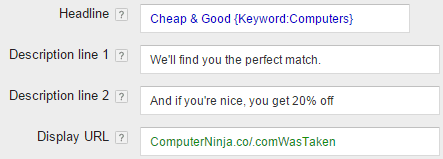First of all, what is Dynamic Keyword Insertion (DKI)?
DKI is actually a kind of tag we can use in text-ads to replace a part of the text with the keyword that triggered the ad. For example:
In a certain ad group we have keywords like computers, laptops and PCs. So we’ll use the word “Computers” as a default value as shown below:

The cool thing is when a user will search for “Laptops”, AdWords will replace the default word “Computers” with it:

So how it’s done?
We write the dynamic keyword this way: {Keyword:Computers}. this word is actually the default value that will be displayed in case that the keyword triggered the ad exceeds the character limit (example: Dell G50-80 Touch, which couldn’t get in with the rest of the headline limited to 25 characters). That being said, sometimes Google will still allow us to exceed our character limit by up to 5 characters in order to show the dynamic value. In addition, Google won’t count {keyword:} as a part of the ad so it won’t “cost” us any characters.
Things to Remember
Before you go live with DKI, it’s important to pay attention to some things that can harm your creative or even cause a trademark violation:
- Make sure that every one of your keywords within the ad group can interchangeably fit in the sentence . I’ll rather move the keyword “Buy Computer” to another ad group so my ad won’t be : “Cheap & Good Buy Computer”, which makes no sense.
- Using your competitor’s names as keywords usually works just fine and gets good results in your PPC campaigns, but when triggering your dynamic ad, it might cause you to break AdWords’s policy or even violate your competitor’s trademark, and believe me – you don’t want that.
Capitalization with DKI
There are 6 ways you can write the tag so it’ll change the the way your keyword is displayed (upper or lower case). It all depends on the way you write the tag:
- {keyword:cheap computer} – All the letters will be displayed as lowercase (cheap computer)
- {Keyword:cheap computer} – the first letter of the first keyword will be capitalized and the rest will be displayed as lowercase (Cheap computer)
- {KeyWord:cheap computer} Every first letter in every word will be capitalised (Cheap Computer)
- {KEYword:cheap computer} – All the letters of the first word will be capitalized and the rest will be displayed as lowercase (CHEAP computer)
- {KEYWord:cheap computer} – The first word will be fully capitalized and the first letter of the rest of the words will be uppercase as well (CHEAP Computer)
- {KEYWORD:cheap computer} – All the letters in the keyword will be capitalized (CHEAP COMPUTER)
What isn’t every one doing?
- Almost everybody uses DKI in the headline, but most of the advertisers don’t use it at all in the description lines, this is your chance to stand out.
- You can also use DKI in the display URL, but make sure it contains only one word since the display URL can’t have spaces.
- Singular vs. plural versions of the keywords. sometimes users will search for “Computer” but if your ad talks about variety, it won’t work. So you can use {Keyword:Computer} and add the letter “s” after the closing tag ({Keyword:Computer}s). Just make sure you don’t have any plural versions in your ad group so that the “s” won’t be doubled.


One thing that I learned the hard way is that you shouldn’t use DKI with broad match KW. Since Google may show your ads for variations of the KW you didn’t intend to show for. Combining this with a dynamic headline may lead the user to think your ad is about a whole different thing than what it actually is.
Any chance you tried to use it without a default value?